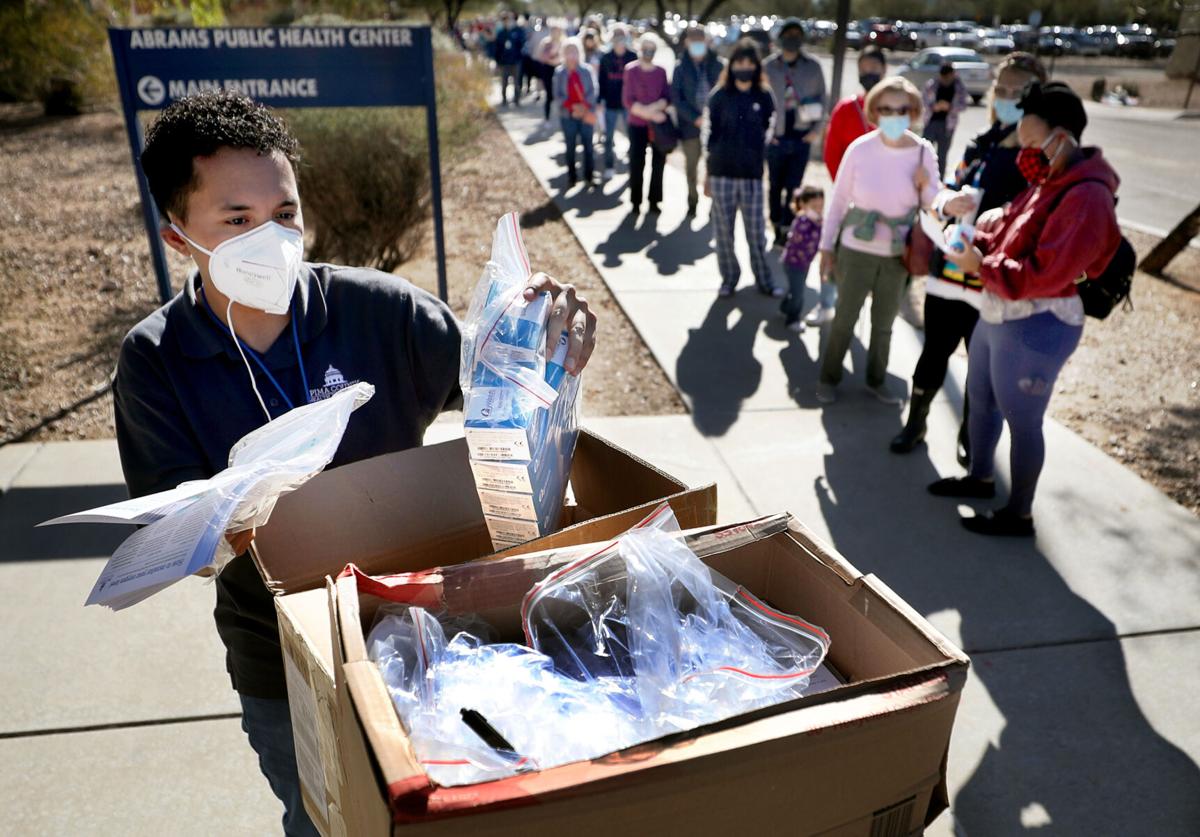More people in Arizona and Pima County tested positive for COVID-19 in the first week of January than any other week on record.
For the second week in a row, new COVID-19 cases more than doubled in both places, this time rising nearly 120% statewide and 130% countywide from Jan. 2 through Jan. 8, which is the most recent, complete week of data.
“We are without a doubt in a very accelerated phase of this pandemic here in Arizona,” said Dr. Joshua LaBaer, executive director of Arizona State University’s Biodesign Institute. “And there’s no sign of it slowing.”
The highly contagious omicron variant is infecting so many people that hospitals in Pima County are allowing some health-care workers who have COVID-19 to work.
So many health-care workers are getting sick that it’s exacerbating the staffing shortage in hospitals, said Pima County Health Department Director Dr. Theresa Cullen.
For example, an executive at Banner Health sent an internal memo to staff on Dec. 13 telling them that they could decide to work, even if they tested positive for COVID-19, if they are asymptomatic or have mild symptoms and take certain safety precautions.
Ultimately, it’s up to individual employees to decide, according to the memo, but supervisors may send employees home if they appear too ill.
Banner Health based this policy change on updated guidance from the Centers for Disease Control and Prevention that outlines when employees should return to work.
This decision to allow infected staff to work is becoming more common among hospitals in Pima County and across the nation.
For example, Tucson Medical Center also chose to adopt a similar policy, which does not require an infected employee to test negative for COVID-19 before returning to work, according to a TMC spokeswoman.
“We are aware of other Arizona-based health delivery systems that adopted similar crisis staffing models during the week of Jan. 10, 2022,” Cullen said. “Health-care systems need to be able to care for patients and keep their doors open. Many hospitals throughout the country are in similar situations to those in Pima County.”
Hospitals are stuck between and rock and a hard place, said Dr. Joe Gerald, an associate professor with the University of Arizona’s College of Public Health.
It was “necessary” for these hospitals to make these decisions, he said, but he stopped short of characterizing them as good or bad.
“It’s not ideal. It’s not optimal. I don’t think it’s something that the evidence says we should do,” Gerald said. “I think it’s something that the circumstances are requiring of us because all the decisions that hospital administrators face right now are bad. There are no good options.”
On Jan. 13, only 7 adult ICU beds were available in Pima County, or about 2% of all these beds, according to data published by the county’s health department.
On the same day across Arizona, 75 adult ICU beds were available, or 5% of all these beds, according to data published by the ADHS.
“Hospitals are at capacity. As more COVID patients are admitted, fewer non-COVID patients are able to receive care in a timely fashion, so their care is delayed,” Gerald said.
“If you were to show up and you’re having a heart attack and it’s an obvious medical emergency, just like COVID would be potentially a medical emergency, those patients are going to get admitted,” he said. “So it’s someone else further down the acuity line that doesn’t get the bed.”
Hospitals in Arizona have seen 7 to 10 days of increasing occupancy in general wards, but ICU occupancy hasn’t increased by much, Gerald said, adding that it’s hard to know where hospitalization numbers are going from here because they tend to lag behind cases by about a week or so.
Gerald thinks, however, that COVID-19 hospitalizations will rise through the end of the month, peaking 7 to 14 days after cases peak. Then he expects cases and hospitalizations to decrease.
It’s too soon to know just how deadly the current wave of COVID-19 cases will be since death data lags behind data on cases and hospitalizations by several weeks.
However, Arizona’s cumulative COVID-19 death rate, which is calculated from Jan. 21, 2020, is the second highest among states, with 343 deaths per 100,000 people. Mississippi has the highest rate, with 355 deaths per 100,000, according to data published by the CDC.
“What we have been told to expect is here. What happened in South Africa, Western Europe, the East Coast is now happening here. What we’re going to see is a rapid escalation. Cases probably top out somewhere around 2,500 cases per 100,000 residents,” Gerald said. “I’m still thinking a peak is very likely almost certainly before the end of the month.”
Arizona had about 1,500 cases per 100,000 people in the first week of January, according to data from the ADHS.
Gerald said that it seems enough people over the age of 50 have been fully vaccinated in Pima County to keep the hospitals from imploding.
“We could have done better,” he said. “But it looks like we may have done just well enough to, once again, eke by.”





